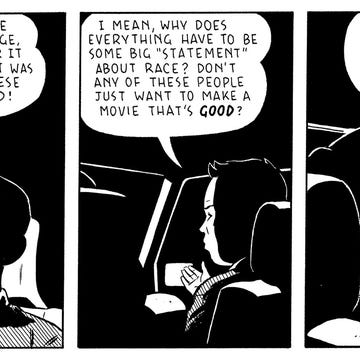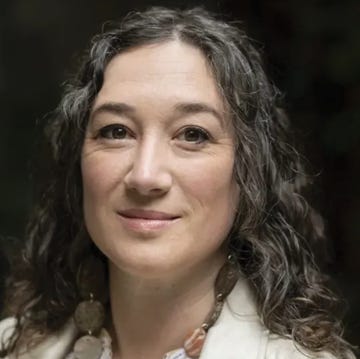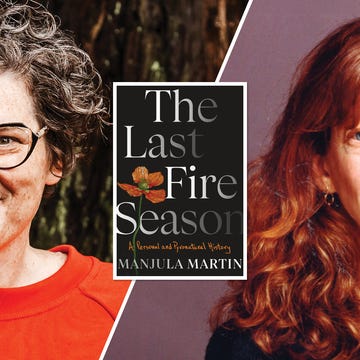Late adolescence is a recipe for intensity: Hormones flare within not-quite-adult bodies, grown-up responsibilities bridle against childhood limits, and establishing identity takes on life-or-death importance. Nothing matters as much as what mattered to you when you were 16. The stakes have never been so high—or so ephemeral. Decades later, will anyone care if you won or lost a championship match? How do we reckon with the time we spend as “a half thing, a half human, a.k.a. a teenager”? What are these in-between years even for?
These questions echo throughout Rita Bullwinkel’s stunning debut, Headshot. Here, in the dank of Bob’s Boxing Palace in Reno, we meet the eight teenage quarterfinalists in the decidedly unglamorous Daughters of America boxing tournament. From a desperate lifeguard haunted by a boy she didn’t save to a dedicated conformist eager to excel at everything to an unabashed proponent of a “weird-hat philosophy” to the scion of a boxing dynasty, this eclectic set is bound together by two powerful forces: the experience of “young girls who grew up being treated as young women” and the compulsion to “be the best in the world at boxing.”
This desire for greatness—even if it is a shabby sort of greatness, one that no one else, often not even their families or their coaches, cares much about—forms the foundation of each girl’s identity. It is the pillar around which the girls have built themselves in both deference to and defiance of the world. Each has poured in blood, sweat, and tears at her local gym, driven hours, and pinched pennies to punch other girls at a tournament no one has heard of, before nearly empty seats. Yet, as adult readers, we envy them—like the grown-ups cavorting at nearby casinos, we too “wish [we] wanted anything as bad as these girl boxers want to be the best in the world at something.”
This wanting gives the girl boxers power: the ability to emerge as fully fledged heroes in their own stories. Here, Headshot jettisons the tired trope so often trotted out in tales of young women competing in a traditionally male arena: There’s no crusty old coach, some brooding also-ran who must reckon with his own misogyny and learn to embrace the greatness of a female mentee. Instead, the men are relegated to the background. As coaches and referees and judges, they control the money, the gyms, the Women’s Youth Boxing Association itself—but they remain unnamed, irrelevant. They are the “stoned older brothers” eclipsed by the girl boxers’ undeniable main-character energy, “dull around the edges in a way that glares compared with the searing radiance of these girl fighters.”
But what happens when that drive for greatness falters? For Kate Heffer, the people-pleasing conformist blessed or cursed with the ideal body for boxing, this faltering happens midfight. Even as she recites the digits of pi to pace her hits, Kate arrives at the uncanny realization that “winning doesn’t always count as winning.” Reflecting on how the second-best female swimmer has garnered more global fanfare than the top one, she concludes that the real contest is about “being a good girl in a certain way, saying the things you are supposed to say, and, above all, looking and talking the part of the role you’ve been assigned.” The revelation shatters her ambitions—once she sees that this match “actually has absolutely no meaning in her life,” she loses any shot at victory. After her defeat, she “completely reimagines the history of her own wanting, and decides that winning this match…[was] just a thing she was trying because other people told her she would be good at it.” After all, society isn’t kind to women who want something too badly, especially when they fail. Kate takes these lessons to heart—as an adult, she’ll excel in a sphere where a desire for perfection is not just acceptable for women but expected: wedding planning.
Sooner or later, each quarterfinalist must face what it means to no longer be a boxer. For Andi Taylor, the haunted lifeguard, boxing becomes a “failed identity marker” as she realizes that she “as a boxer didn’t fit the way the world needed her to be in order for her to survive.” The constraints of womanhood, the faded texture of middle age, are inescapable. The lives of the former girl boxers grow quiet, settled, good enough but not extraordinary: One becomes a grocery store manager; another, a pharmacist.
And yet, the impact of their boxing days lurks beneath the surface. One thrills each time she passes a boxing gym on the way to her “just fine” job as a career administrative assistant; another will recall “the drive—the total abandon, and obsessiveness, with which she fought” when she resolves to reclaim her body from atrophy. For the youngest sister of the boxing dynasty, her sole memento is permanently damaged hands; her fighting self is long forgotten, but its physical consequences persist. Andi can’t shed that identity completely. When she builds a house with the person who “makes her relieved to be alive,” he will gaze at her and “think that it is not a wonder that Andi Taylor was once a boxer.” Maybe a ghost of that radiant adolescent intensity lingers in all of us if we know how to look for it.•
Join us on March 20 at 5 p.m. Pacific time, when Bullwinkel will sit down with special guest Lucy Corin and CBC host John Freeman to discuss Headshot. Register for the Zoom conversation here.
“INTIMACY OF STARING”
Check out critic and artist Nichole LeFebvre’s essay on character-driven fiction and Bullwinkel’s novel. —Alta
THE SWEET SCIENCE
Revisit books editor Anita Felicelli’s profile of Bullwinkel. —Alta
DIFFICULT CHILDHOOD
Journalist Min Liao reviews Neko Case’s memoir, The Harder I Fight the More I Love You. —Alta
SECRET ORIGINS
Critic Carolyn Kellogg reviews Mayukh Sen’s Love, Queenie: Merle Oberon, Hollywood’s First South Asian Star, a “breezy” new biography that narrates the life of Hollywood star Merle Oberon with “sensitivity and verve.” —Los Angeles Times
SCIENCE AND LITERATURE
Prior CBC author Kim Stanley Robinson will be talking with artist Ala Ebtekar at Arion Press on March 12 at 6:30 p.m. at Bayfront Theater in San Francisco. —Eventbrite
HARROWING PREGNANCY
Kevin Canfield writes about Samina Ali in connection with her memoir of preeclampsia and brain trauma, Pieces You’ll Never Get Back: A Memoir of Unlikely Survival. —San Francisco Chronicle
Alta’s California Book Club email newsletter is published weekly. Sign up for free today.



















